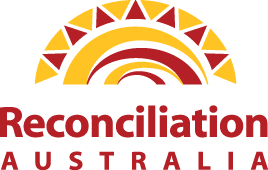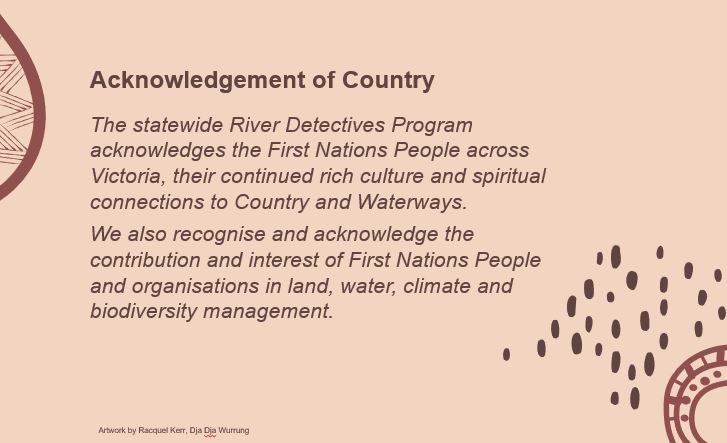Aboriginal Cultures
Explore the culture of Traditional Custodians and embed Aboriginal perspectives into your learning
Australians Together website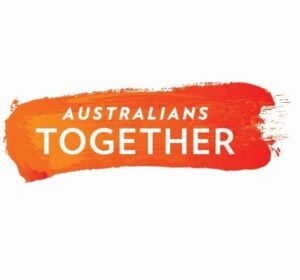
A portal for free F-10 resources created together with First Nations cultural collaborators, for professional learning and for articles/stories to learn more about our shared history.
|
Back to Nature (ABC TV) education resources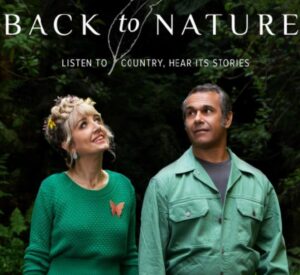
Comprehensive education materials for primary and secondary schools have been developed by Culture is Life to deliver key themes from the successful ABC Series Back to Nature, available on ABC iView. Key themes include Geology, History, Natural Science, Spirituality, Custodianship, Creation, Kinship, Healing, Belonging & Connection. Teachers can explore inquiry and discussion questions, activities for year levels 2-6, extended resources for year levels 7-10, pre-screening guidance and cultural considerations for teachers to support the delivery of Indigenous knowledge and perspectives in their classroom. Click here for Level 2-6 digital resources (click your mouse to scroll through) or click here for Level 7-10 resources.
|
Wanyarram Dhelk Bendigo Creek site signage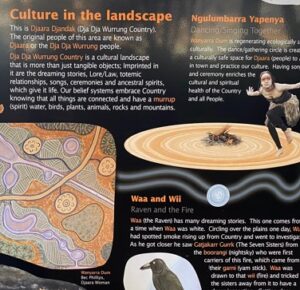
The gorgeous interpretive signs on site at Bendigo Creek’s Wanyarram Dhelk site near Knight St White Hills are a wealth of information about the cultural significance of waterways, caring for country (djandak) and water (gatjin). A visit to the site is a must do for schools in the Bendigo area. Learn more about the site by watching this video.
|
Bendigo Creek restoration video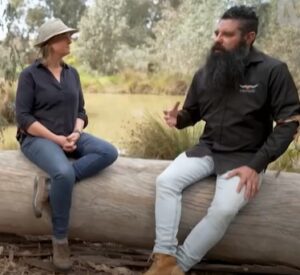
Clarence and Millie from Gardening Australia present a marvellous segment on Gardening Australia about the way Bendigo Creek is being reimagined, the way cultural knowledge is being embedded and the way we are looking to the future to bring back species and value this important urban waterway.
|
Indigenous Plant Use booklet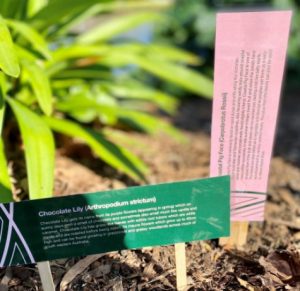
This booklet describes the medicinal, nutritional and technological uses of native plants found widely across the eastern Kulin Nation. The guide increases awareness of cultural plants although we suggest you seek advice from your local Traditional Owner group for specific information. The guide will help you design and establish a cultural garden with plant labels you can print, laminate and install.
|
Taungurung Land and Waters Council and the Caring for Campaspe project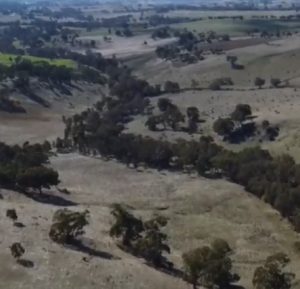
This is a great overview of the goals and benefits of the Caring For The Campaspe project, explaining to students how the NCCMA work alongside Traditional Owners and the actions they take to protect and enhance our waterways.
|
2022 Campaspe River Tour video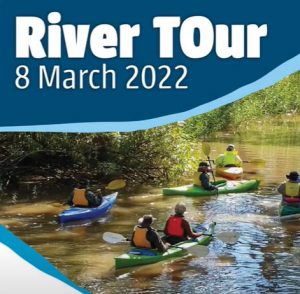
The Caring for the Campaspe project once again invited Traditional Owners together to spend time on Country to share, explore and learn from each other. Hear from participants about how valued this experience is.
|
The Mysterious World of Eels video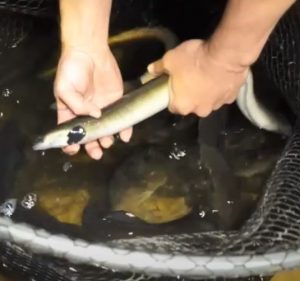
This recording of an ARI seminar features Uncle Denis Rose and Dr Wayne Koster presenting on their partnership in eel migration research. It shares the importance of eels (both culturally and ecologically) and what we’ve learned through satellite tracking. The video runs for 1hr and is suitable for older viewers as a rare chance to dive deeper into the mysterious world of eels.
|
Manungaboomboom – Uncle Rick Nelson video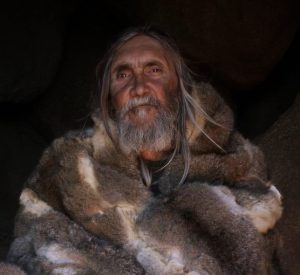
Uncle Rick Nelson’s story of Dja Dja Wurrung People and the impacts of colonisation on Dja Dja Wurrung County. Filmed in and around Leanganook, Mt Alexander region. This is a powerful and important story but please be aware there is some graphic content for younger viewers.
|
Wanyarram Dhelk, Bendigo Creek site tour video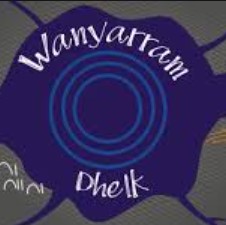
Wanyarram Dhelk is a cultural expression encapsulating what Bendigo Creek once was, a series of waterholes that provided food and fibre resources as well as recreational opportunities for Djaara people. This important project demonstrates how integrating Traditional Owner knowledge with water sensitive design can help restore cultural, social and environmental values to a degraded urban creek and is a great example for students. Wanyarram Dhelk has provided an example for the whole community of the potential to ‘Reimagine Bendigo Creek’ and embrace its possibilities as a valued natural resource. Use this case study to learn more, visit the site with your students, talk with traditional owners about the project or do some of your own ‘reimagining’. The case study can be accessed here or view this great video about the City of Greater Bendigo’s new Reconciliation Plan.
|
Barapa Water for Country video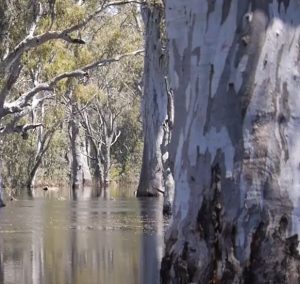
A great video to showcase the importance and value in collaborating with Traditional Owners to understand, explore and heal country by embedding cultural knowledge, skills and aspirations in land management decisions. Follow the journey of the project; See here for a look at how the project began and for more information about its goal to work with the Barapa Cultural Team and identify, map and record the cultural values of the Lower Gunbower Forest to improve the management of environmental water. See here for the 2019 video.
|
Intergenerational Trauma animation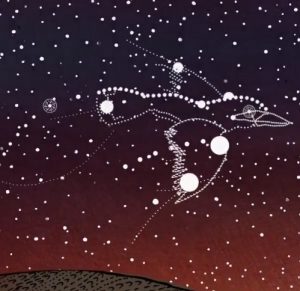
In Australia, Intergenerational Trauma predominantly affects the children, grandchildren and future generations of the Stolen Generations. This is a confronting topic causing all Australians to reflect on our shared history. Care should be taken about how/when this content is presented but the video from the Healing Foundation is extremely well done and thought-provoking to stimulate conversations with older students.
|
Share Our Pride website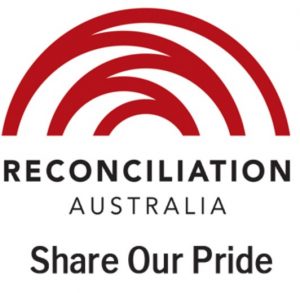
This website by Reconciliation Australia provides introductory cultural awareness training to give non-Indigenous people a glimpse into the lives and cultures of Australia’s First People. It has been put together for organisations to consider what they might do differently to build better relationships with Indigenous peoples to show respect for Indigenous Australians and to create opportunities for Indigenous peoples to help close the life expectancy gap and build a stronger Australia. The content is simple and presented in a very user-friendly, engaging format. Users can take the journey through each ‘chapter’ simply by scrolling down and clicking links or selected chapters/videos can be viewed. Note: Please preview content for its suitability to the age group you are teaching.
|
The history of Mt Greenock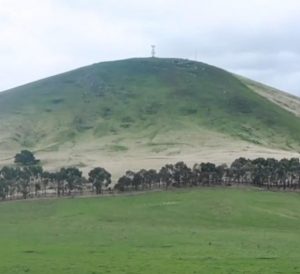
Time travel back 180 years to rarely visited places and events from the early contact period that marked the beginning of unimaginable loss and trauma for Dja Dja Wurrung people. Join Jaara Elder, Uncle Ricky Nelson and Professor Barry Golding as they stand together and reflect on top of the iconic volcanic slopes of Mount Greenock. This video teaches students a different way to look at their local landscape with fresh eyes and appreciate its history and significance to Aboriginal people. This is one of three videos in this series. You can also watch videos about the Loddon River at Neereman and Merin Merin wetland.
|
Traditional life at Merin Merin wetland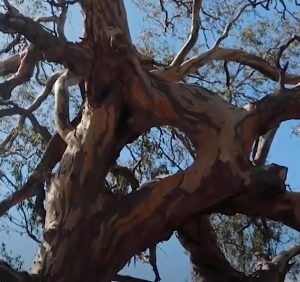
Join Jaara Elder, Uncle Ricky Nelson and Professor Barry Golding as they stand together on the top of the iconic volcanic slopes of Mount Greenock and explore the life-providing Merin Merin Wetland near Clunes where kangaroos still graze, highlighting the European and Aboriginal history of the site. This video teaches students a different way to look at their local landscape with fresh eyes and appreciate its history and significance to Aboriginal people. This is one of three videos in this series. You can also watch videos about the Loddon River at Neereman and Mt Greenock.
|
Loddon River at Neereman video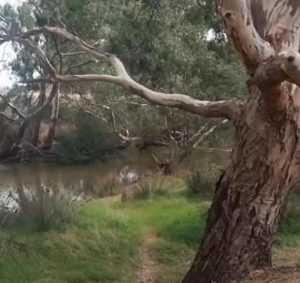
Time travel back 180 years to rarely visited places and events from the early contact period that marked the beginning of unimaginable loss and trauma for Dja Dja Wurrung people. Join Jaara Elder, Uncle Ricky Nelson and Professor Barry Golding as they stand together on the top of the iconic volcanic slopes of Mount Greenock to give a fascinating insight into the history of the Loddon River at Neereman near Baringhup and the early interactions between European and Aboriginal people. This video teaches students a different way to look at their local landscape with fresh eyes and appreciate its history and significance to Aboriginal people. A must watch if you’re studying the life and times of the Loddon River. This is one of three videos in this series. You can also watch videos about Merin Merin wetland and Mt Greenock.
|
City of Greater Bendigo – Our Vision for Reconciliation video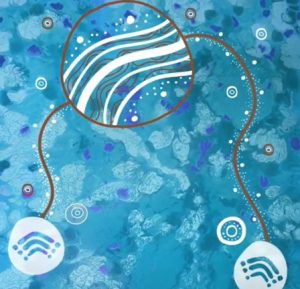
In November 2020, the City of Greater Bendigo launched its new Reconciliation Plan 2021-2025, Barpangu. Meaning ‘build together’ in Dja Dja Wurrung language, Barpangu was developed through conversations and consultation with the Dja Dja Wurrung and Taungurung Traditional Owners, the broader local Aboriginal and Torres Strait Islander community, and City staff. It builds on the success of their first Reconciliation Plan and aims to further advance reconciliation across the municipality. It is great example for students of how organisations can actively work on and promote reconciliation.
|
2023 Koorie Education Calendar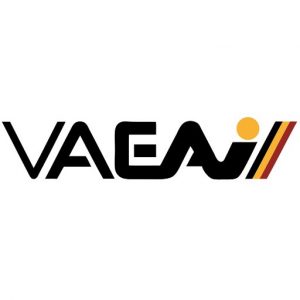
Framed around significant events throughout the calendar year, the interactive Koorie Education Calendar has been developed by VAEAI to assist educators and learners alike. The Calendar draws the learner to Victorian Koorie voices, stories and achievements, and features Koorie leaders, artists, authors, playwriters and more. The Koorie Education Calendar is updated annually and can assist schools in planning for key events and locating information about Victorian Koorie cultures, histories and perspectives. Designed to be printed on A3 paper.
We strongly recommend consulting with Aboriginal people and Aboriginal sources for information. Where available, your local LAECG is a good first point of contact and VAEAI can assist with contacts. Try to work with local community people and Elders, and always respect their intellectual and cultural property rights.
|
Annual Environmental/Cultural Celebration Dates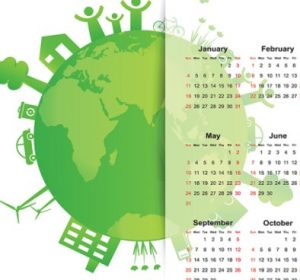
Schools and the community are invited to recognise and celebrate significant environmental / cultural days each year; some are regional, some national and some international. Many of these days tie in perfectly with the ethos of the River Detectives program and provide valuable opportunities to broaden/deepen environmental learning and encourage your students to advocate on a range of environmental and cultural issues. Check out this calendar (embedded with loads of links) and go wild !!
|
Easter Basket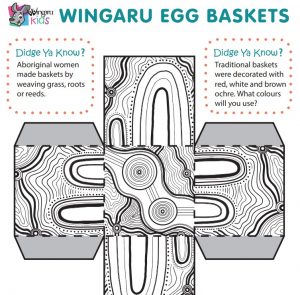
While Easter is not an Aboriginal celebration, eggs were a big part of customary life and looking at how Aboriginal people used eggs is a great perspective for all age groups at Easter time. The protocols around egg gathering took into consideration the sustainability of the species producing them. Eggs were respected as a source of life as well as nourishment for mob. Eggs would be collected in vessels weaved by Aboriginal women from the naturally available reeds and materials of the local area. This Easter printable features the artwork of Darug Artist, Chloe Webb.
|
NAIDOC Week website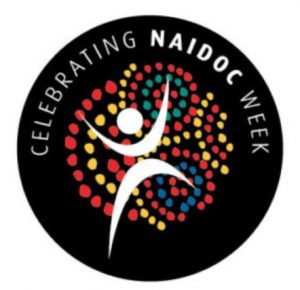
The learning resources available to all students through the NAIDOC website are invaluable for teachers and students. The NAIDOC teaching ideas developed by the National NAIDOC Committee relate directly to supporting teachers in addressing The Australian Curriculum: Aboriginal and Torres Strait Islander Histories and Culture cross-curriculum priority; with provision of content that can be used across multiple learning areas and stages/grades from Foundational Studies to Year 12. The teaching resources released each year for the annual theme provide Aboriginal and Torres Strait Islander perspectives for classrooms beyond the dates of NAIDOC Week each year.
|
Earth Ovens – Celebrating Aboriginal Intangible Heritage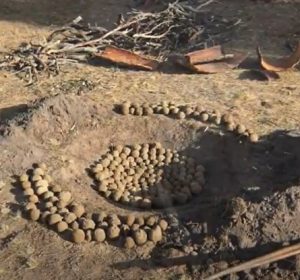
In November 2016, Barengi Gadjin Land Council, in partnership with Maurizio Campanelli, held Bakang Dyakata – a traditional Aboriginal earth oven recreation event. This annual event, held on the banks of the Wimmera River, brings the community together to cook using traditional techniques and taste native foods. It is an example of the rich intangible heritage of Aboriginal communities in Victoria.
|
Connection to Country: Leanganook (Mt Alexander Regional Park) video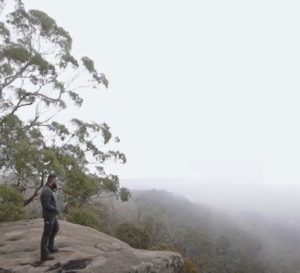
Follow Ranger Trent, a proud Dja Dja Wurrung and Yorta Yorta man, through Leanganook/Mt Alexander Regional Park as he describes the importance of connecting to and caring for Country. A lovely video to see the landscape through a different lens for students in central Victoria.
|
Cultural Fire and Healing Yorta Yorta Country video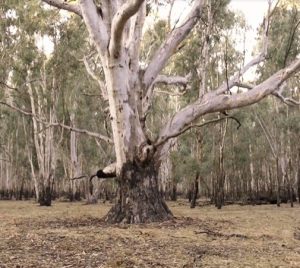
Listen to Yorta Yorta man Ralph Hume discuss cultural fire and healing country at the 2019 National Indigenous Fire Workshop near Dhungala (Murray River), Victoria, Yorta Yorta Woka (Yorta Yorta Country). A very interesting insight into how the landscape has changed since European settlement, why the riparian environment we see today is not considered healthy by traditional owners and how it can be healed.
|
Dja Dja Wurrung Tanderrum cultural ceremony video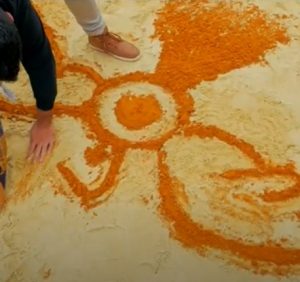
This is a powerful video put together when the Dja Dja Wurrung participated in the Melbourne Festival Opening in 2016 at Federation Square. Dja Dja Wurrung traditional owners joined five groups from the Kulin Nation in a tanderrum; a ceremony of welcome and hospitality for visitors to the land of the Kulin Nation. The video highlights the importance of cultural ceremonies to traditional owners, particularly now as a way of healing injustices of the past.
|
Brolga Bangarra Dance Theatre video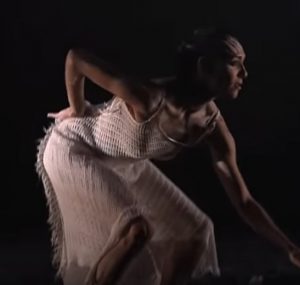
The brolga is a majestic bird of Victoria’s wetlands and has long been held as an important totem in traditional life. Watch a video of brolga’s visiting Tang Tang Swamp or a video about the birth of a brolga in central Victoria then enjoy watching the way the Bangarra Dance Theatre represents brolgas through dance.
|
The Water Tribe and Ochre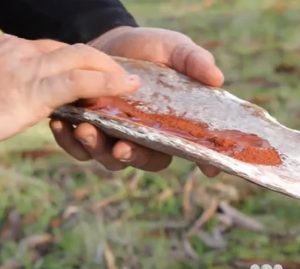
Proud Wathaurung man Barry Gilson is learning and writing songs in the language of his ancestors – a difficult task because “everything has been lost”. What does he mean by this? He also speaks of how ochre was and is used in Aboriginal ceremonies.
|
Budj Bim eel trap system video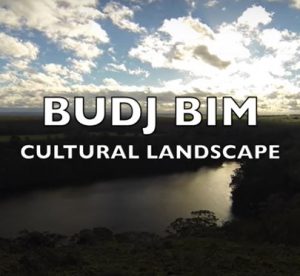
Budj Bim is a dormant volcano in South Western Victoria on Gunditjmara Country. Budj Bim means High Head in the language of Gunditjmara people and is home to one of oldest aquaculture systems in the world. Budj Bim is said to have erupted over 30,000 years ago and the lava flow that resulted created a system of channels that Gunditjmara people developed into weirs, dams and traps for fish and eels. Older students may wish to find out more about the UNESCO World Heritage-listed Budj Bim National Park by watching this 30 minute virtual tour presented by the Glenelg Hopkins CMA for the 2020 Victorian Nature Festival.
|
Seasonal Calendars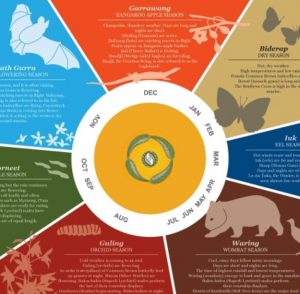
Aboriginal people traditionally lived by seasonal calendars not dictated by the conventions of summer, autumn, winter and spring but by the changes they observed in nature throughout a year. This is one example of a Kulin Nation seasonal calendar. You might be able to source one that is more specific to the traditional owners of your area ? Click here for an outline of the Wotjobaluk seasonal calendar for the Wimmera-Mallee area or view another version at the Visit Grampians website. Click here to watch a video about Dja Dja Wurrung seasons. Keep observations of your waterway and local catchment throughout a year with your students and make your own text or pictorial calendar inspired by a traditional seasonal version or this riparian/agricultural example from the North Central CMA. . . . .or combine the two !
|
Edithvale-Seaford Wetland video series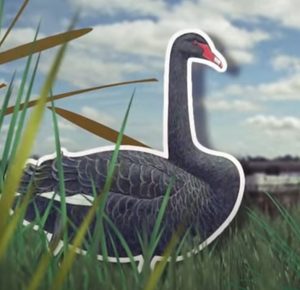
These six educational videos focus on the Edithvale-Seaford Wetlands in the Melbourne Water area, exploring their fauna and flora, rich history, role in providing drainage, and the community groups who play a key role in caring for them. Get a well-rounded understanding of the wetland’s many diverse roles, by watching the full video series: Animals of the wetland Birds of the wetland Drainage story of the wetland Friends of the wetlands History of the wetland Plants of the wetland
|
Plants of the Wetland video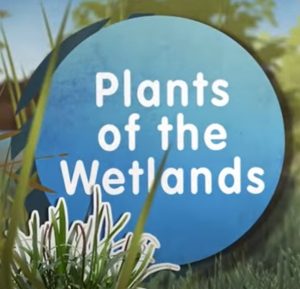
Learn why plants are important to a wetland, and how some were used by indigenous people for food, fibre and medicine. Filmed at the Edithvale-Seaford wetlands where there are 87 plant species with records of Aboriginal use, this is a great video for students in any region to understand the role wetland plants play. This is one of six educational wetlands videos featuring the Edithvale-Seaford Wetlands.
|
How the Murray River was made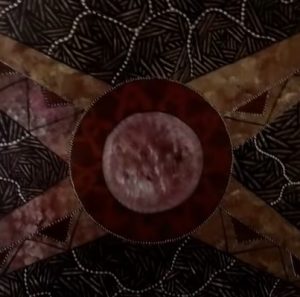
Many of the waterways in northern Victoria enter the Murray River. Enjoy this re-telling of the story as it has been come to be learned by Narjiic Day-Burns.
|
Tarrengower and Lalgambook: A teaching from the Jaara Jaara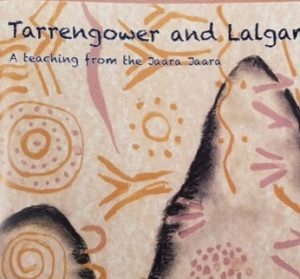
As part of North Central CMA’s 2020 NAIDOC week celebrations, Aunty Marilyne Nicholls spent time on Country at beautiful Tarrengower to share this special creation story of a Dja Dja Wurrung storyline from central Victoria. This book was created by the kids at The Meeting Place and proudly published by Nalderun.
|
Uncle Bryon Powell Interview on the Barwon River, Wadawurrung Country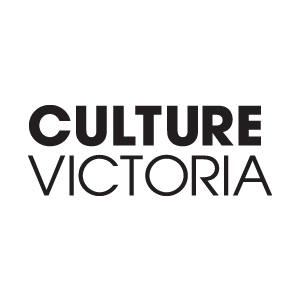
In this extended interview Uncle Bryon Powell, Wadawurrung Elder and Chair of Wathaurung Aboriginal Corporation, discusses the significance of bark canoes, the impacts of colonisation and the changes to the river landscape for Wadawurrung (Wathaurung) people, and hypothesises what life must have been like for a Wadawurrung man who helped a white domestic servant cross the Barwon River in the 1840s. Please note this is an audio interview, not video. For other cultural/historical videos, documents, photos, etc about waterways near you, type the name of your creek/river into the search bar of the Collection Search tab of the Culture Victoria website. You’ll be amazed at what you find !
|
Rick Nelson Interview at Bet Bet Creek, Dja Dja Wurrung Country
In this extended interview Rick Nelson, Jaara descendant, is interviewed by Lucinda Horrocks on the banks of the Bet Bet Creek, in Eddington, Victoria, part of the traditional land of the Dja Dja Wurrung language peoples. Please note this is an audio interview, not video. Rick talks about how Aboriginal bark canoes were made and what they were used for in the swamps and waterways of Dja Dja Wurrung language country. He talks about the impacts of colonisation and the gold rush on the landscape on the lives of Dja Dja Wurrung people. Lucinda and Rick discuss the life of ‘King Tommy’, an Aboriginal man who lived close by, never far from the Loddon River, in the 19th century. For other cultural/historical videos, documents, photos, etc about waterways near you, type the name of your creek/river into the search bar of the Collection Search tab of the Culture Victoria website. You’ll be amazed at what you find !
|
Sharing culture across Wadawurrung country video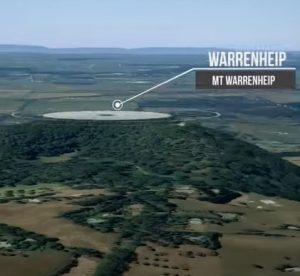
ABC’s ‘This Place’ project invites Aboriginal and Torres Strait Islander people to create a short video about a place name, and the story behind it. Bryon Powell takes us on a journey across Wadawurrung country, sharing some of the stories behind its place names. His country stretches from the mountains to the sea. It includes hills, rivers and grassy plains, creeks and coasts and includes modern towns such as Werribee, Geelong and Ballarat in Victoria. Search for other videos of cultural stories about waterways across regional Australia at the ABC TV Education website, on ABC iview or at the ABC Indigenous youtube channel.
|
Sharing culture at Barengi Djul (Wimmera River) video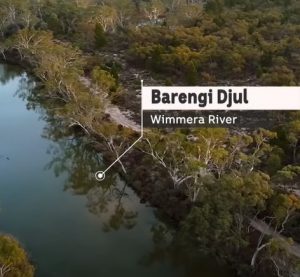
ABC’s ‘This Place’ project invites Aboriginal and Torres Strait Islander people to create a short video about a place name, and the story behind it. The Wimmera River is known as Barengi Djul in Wergaia language spoken by the Wotjobaluk people. Along the water, not far from the township of Dimboola is a special place known as Ackle Bend or Wutiyeti which means camping place, and is also known for its stories of Bunyip. Search for other videos of cultural stories about waterways across regional Australia at the ABC TV Education website, on ABC iview or at the ABC Indigenous youtube channel.
|
Seeing the land from an Aboriginal canoe video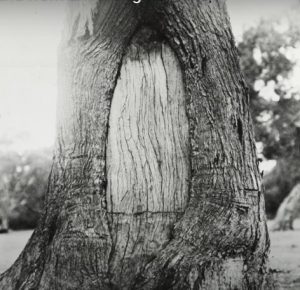
This 10 minute video gives a wonderful insight into the way 19th century European settlers depended on Aboriginal navigators and canoe builders to transport goods, stock and people. This short documentary film explores the little known contribution Aboriginal people made in colonial times across the river systems of Victoria. It features interviews with the historian Associate Professor Fred Cahir and Traditional Owners Uncle Bryon Powell, Jamie Lowe and Rick Nelson. For other cultural/historical videos, documents, photos, etc about waterways near you, type the name of your creek/river into the search bar of the Collection Search tab of the Culture Victoria website. You’ll be amazed at what you find !
|
SBAT with the NCCMA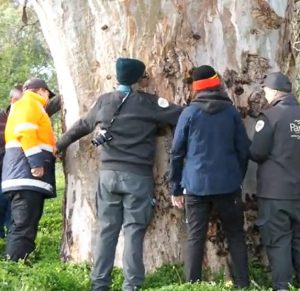
School Based Apprenticeships and Traineeships (SBAT) are available for high school students over the age of 15 years. Students work for an employer and train towards a recognised qualification while completing their secondary schooling and studying for their VCE or VCAL. The North Central CMA have hosted three students during 2020 helping them build connection to their culture, environmental knowledge and skills, self confidence and career pathways. If you’re an older student looking for inspiration this video shows how SBAT and natural resource management organisations can work together for great outcomes.
|
You And Me, Murrawee picture story book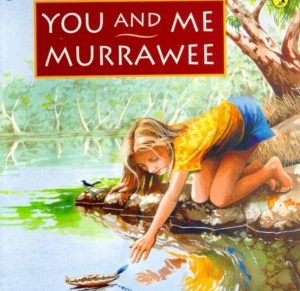
You And Me, Murrawee by Kerri Hashmi is a simple yet very powerful story for primary aged children about the rhythms of daily life beside a river and the many reasons we enjoy time by the water. It highlights the timeless appeal of rivers, the constant yet ever-evolving circle of life for people/plants/animals and prompts us to evaluate modern and traditional life through the subtle revelation that the characters are living 200 years apart. Murrawee means ‘elder sister’ in the language of the Ngarrindjeri people from the Murray River in South Australia but this story is set at an unnamed river and can be used in any location. Enjoy this online reading of the story or purchase the book at your favourite book store. Teacher notes for the story are not available but endless learning opportunities abound.
|
Wilam: A Birrarung Story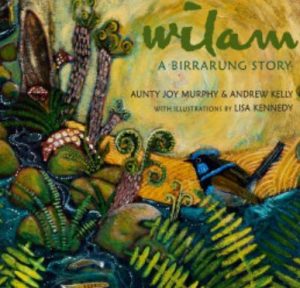
Wilam: A Birrarung Story is written by Aunty Joy Murphy and Andrew Kelly and illustrated by Lisa Kennedy. It tells the Indigenous and geographical story of Melbourne’s Yarra River, from its source to its mouth, from its pre-history to the present day and includes words from the Woiwurrung language. There are no online versions of this book but a hard copy can be ordered at your favourite book store. Comprehensive cross-curricular teacher’s notes are a wonderful guide to implementing this beautiful book in the classroom.
|
Traditional Owners of Australia – text version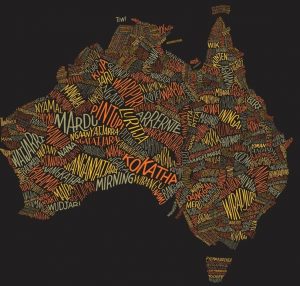
This is a different take on standard maps showing the traditional owner areas across Australia with groups displayed as text rather than shaded colours. It’s an extremely effective way of showing the diversity of Aboriginal cultures.
|
“Where’s Our Water” digital picture story book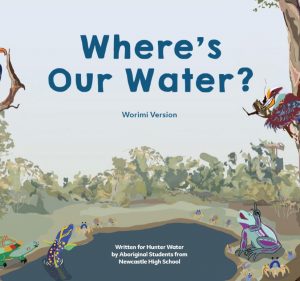
This book came out of a project co-ordinated by Hunter Water in NSW. Although it is not local, the story has valuable messages that apply to any catchment and the project is an inspiring example of what can be achieved when students work closely with traditional owners. Where’s Our Water? has been written for primary school students in the Lower Hunter region to teach them about the value of water as a precious resource and that it is everyone’s responsibility to care for it to ensure we have enough now and into the future. Hunter Water has collaborated with both the Awabakal and Worimi communities to create this new story that draws on their traditional wisdom and practices of caring for our land and waterways. You can also watch a video about the project.
|
NCCMA region Traditional Owner map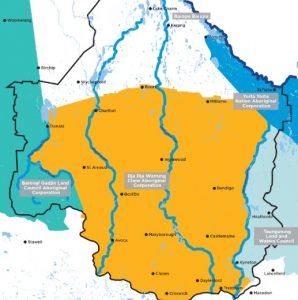
This map (current July 2020) shows the Traditional Owners within the North Central CMA region and it’s catchments.
|
Surveying Gurru (Lake Hindmarsh)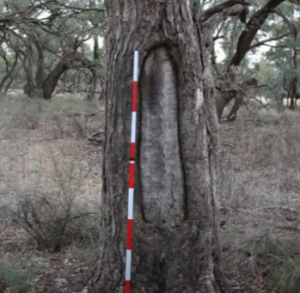
This documentary was created as part of National Reconciliation Week 2016 by Barengi Gadjin Land Council and Cooper Heritage Management to highlight cultural heritage survey activities on the iconic Lake Hindmarsh in western Victoria. Their findings help us understand how the area was traditionally used and the importance of Lake Hindmarsh in the past, present and future.
|
Mooroobull Yaluk Kuwin River Day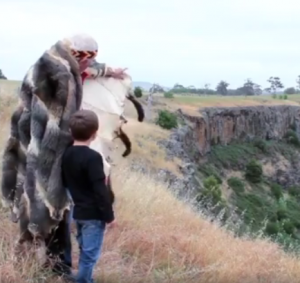
In February 2018 the Corangamite CMA and Wathaurung Aboriginal Corporation hosted a community fishing day with the Wadawurrung community on the Moorabool River.
|
Celebrating Water and Culture on The Mooroobull Yaluk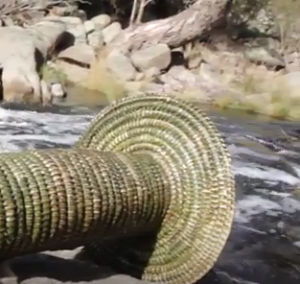
Corangamite CMA worked with the Wadawurrung Traditional Owners in developing a joint bid for additional water for the Moorabool River. This was to protect the environmental and Aboriginal values within the rivers on Wadawurrung Country. The bid was successful and an additional 500 megalitres was released down the river when it was most needed. This allowed the Wadawaurrung community to come together, practice cultural values and share their knowledge.
|
Dhelkunya Dja: Dja Dja Wurrung Country Plan 2014 – 2034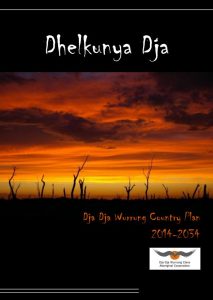
The Dhelkunya Dja Country Plan is about reaffirming the aspirations and describing the future of the Traditional Owners of Dja Dja Wurrung Country.
|
Aboriginal Victoria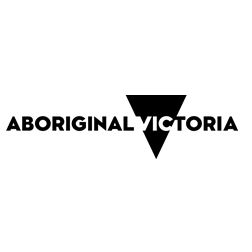
Aboriginal Victoria aims to protect Aboriginal cultural heritage, promote the advancement of Treaty and self-determination, and deliver programs to strengthen Aboriginal communities.
|
Culture Victoria: Aboriginal Culture
Culture Victoria is a gateway to Victoria’s cultural collections and organisations. It provides access to images, videos and stories that showcase the richness and diversity of Victoria. Type a location or waterway into the Collection search to discover content from cultural agencies and over 300 professional and community collections.
|
Victorian Aboriginal Education Association Incorporated (VAEAI)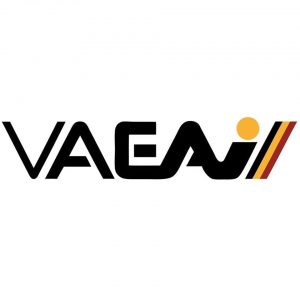
The Victorian Aboriginal Education Association Incorporated, or VAEAI, is the state-wide Aboriginal community-controlled organisation for education and training in Victoria.
|
Aunty Esther’s Story of Change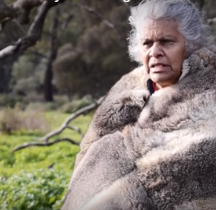
Traditional Owner Aunty Esther tells the story of the Barapa Barapa connection to Gunbower Forest.
|
Barapa Wamba Water for Country River Tour 2019 video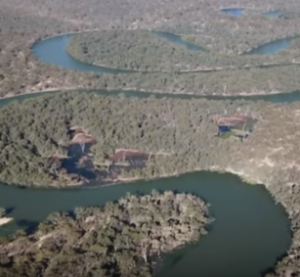
This video showcases an innovative NCCMA event for traditional owners to come together with land managers to spend time on country, learn from each other and allow time together on the river to strengthen relationships.
|
3 Rivers Flow Indigenous Hip Hop project video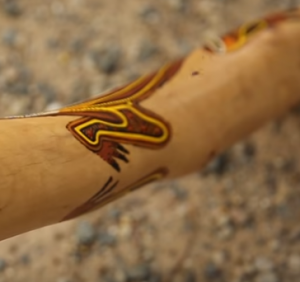
Be inspired by this awesome video of Yorta Yorta children leading their mob in a song about their country defined by three rivers; the Campaspe, the Goulburn and the mighty Murray River. Maybe you could do a similar project with your students to tell (or sing) a story about your local waterway ?
|
Traditional Owner Campaspe River Tour video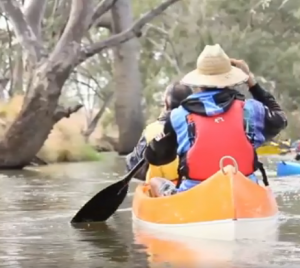
The NCCMA’s Caring for the Campaspe River project means more than just ensuring environmental values are protected and enhanced. The river has a rich cultural history and spending time there is a meaningful way for our Traditional Owners to connect with country and go on a journey of mutual learning with land managers.
|
Traditional Owners Map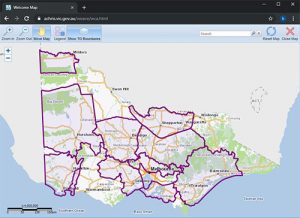
Victoria has a strong and proud Aboriginal history, and complex ownership and land stewardship systems stretching back many thousands of years. This map allows you to find out who the formally recognised Traditional Owners are for an area.
|
Barapa Barapa Field survey plant guide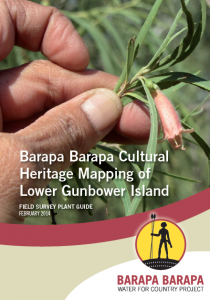
Find out more about plants in the Barapa Barapa region through pictures and descriptions of the plant, it’s habitat and it’s traditional uses.
|
